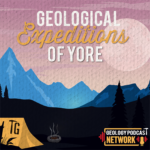
Episode summary:
This episode of GEOY takes you back to the 18th century when James Hutton set out for his famous expedition to Siccar Point, and introduced the concept of geological time. Back in Hutton’s day when it was widely believed that Earth came into creation only about 6000 years ago, the narration of deep time was revolutionary to say the least. In this episode geology researchers Bryant Ware and Janne Liebmann talk about the life and scientific achievements of the “father of modern geology”.
Resources mentioned in this episode:
Check out these articles on Traveling Geologist for more information on Siccar point and some spectacular photos of Hutton’s famous unconformity http://www.travelinggeologist.com/?s=siccar+point
The intro of this episode is from James Hutton’s “Theory of the Earth”.
The bag pipes music from the intro is “The Bee’s Knees” by Joanne Garton.
Host Information:
Dr. Bryant Ware is a geology researcher (an isotope geochemist, and geochronologist for those who want to know exactly) at Curtin University in Western Australia. He knows all about the nitty gritty details of the geochemical analysis of rocks to produce the data that help us to understand the processes that shape our planet. Despite spending an excessive amount of time in the clean lab, he loves the outdoors and spending time in the field. As a member of the Traveling Geologist Team, and the Geology Podcast Network he enjoys to share his excitement about geology with others.
Janne Liebmann recently completed her PhD in geology at Curtin University in Western Australia. Her research aims to create a more accurate picture of the ancient Earth (2-3 billion years ago), and the processes that primed our planet for the development of complex life. She is fascinated by the multiple-billion year long history of the universe and our planet, dwarfing humans to just ‘a recent blip in the cosmos’. As a member of the Traveling Geologist Team, and the Geology Podcast Network she enjoys to share her excitement about geology with others.
![]() This work is licensed under a Creative Commons Attribution-NonCommercial-ShareAlike 4.0 International License.
This work is licensed under a Creative Commons Attribution-NonCommercial-ShareAlike 4.0 International License.
